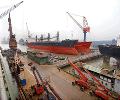

The three major South Korean shipbuilders posted negative earnings surprises, 2,994.8 billion won in total operating losses, for the first half of this year, when they won the biggest number of contracts since 2008. This is because the earnings reflect their slump in 2019 and the price of thick plates surged in the first half.
The operating losses of Korea Shipbuilding & Offshore Engineering, Daewoo Shipbuilding & Marine Engineering, and Samsung Heavy Industries were 829.8 billion won, 1,220.3 billion won and 944.7 billion won in the first half, respectively.
Daewoo Shipbuilding & Marine Engineering’s operating loss amounted to 1,007.4 billion won in the second quarter alone. Its quarterly operating loss exceeded one trillion won for the first time since 2015. Samsung Heavy Industries remained in the red for the 15th consecutive quarter.
This has to do with heavy-tail contracts. In general, a shipbuilder builds a ship by raising money on its own and about 60 percent of the total contract amount is given when it delivers the ship, which means a very large financial burden in the shipbuilding process. It takes about two years for a ship to be delivered after contract conclusion and the earnings data reflect contracts signed in 2019, when ship prices were low and the shipbuilders were underachieving.
The thick plate price, which accounts for about 20 percent of the total cost of shipbuilding, is another factor as mentioned above. The price rose about 20 percent in the first quarter and the Q2 price pre-reflected the rise in price for the second half. Talks between steelmakers and the shipbuilders are underway on the H2 price and the former’s demand is 1.15 million won per ton. The latter reflected 1 million won to 1.15 million won in the earnings data, which is 40 percent to 60 percent higher than the H1 price.
Source: BusinessKorea